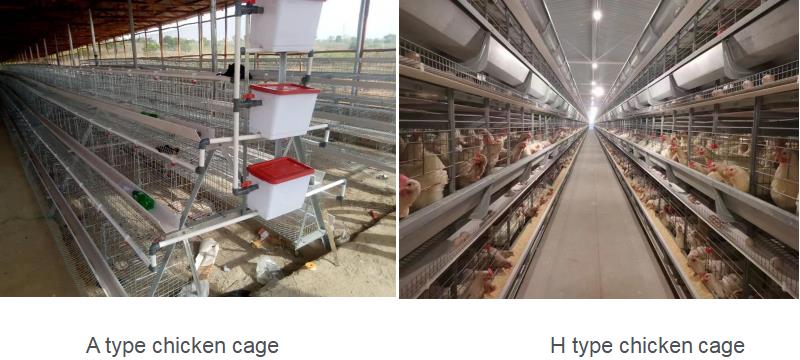Battery cages poultry farming are essential for modern poultry farming, maximizing space and streamlining operations. A-type and H-type battery cages are two popular options, each with unique features suited to different farm needs. This article compares them across six key factors—structure, space utilization, egg collection, feeding and watering, manure management, and cost—to help you choose the right system for your farm.
1. Structure and Design

- A-Type Cages: Shaped like an “A” with a tiered, ladder-like structure (3-4 tiers), these cages are simple to install and maintain. Their open design allows birds to move freely, ideal for small to medium-sized farms.
- H-Type Cages: Resembling an “H,” these cages feature individual compartments with a central aisle. They’re more complex but highly automated, perfect for large-scale operations.
Key Difference: A-type cages are simpler and budget-friendly; H-type cages offer advanced automation for larger farms.
2. Space Utilization and Bird Density
- A-Type Battery cage: High-density design accommodates 10-12 birds per square meter, maximizing egg output. However, good ventilation and hygiene are critical to prevent health issues.
- H-Type: Lower density (8-10 birds per square meter) with individual compartments reduces disease spread and improves bird welfare.

Data Point: Studies show H-type cages can reduce disease transmission by up to 20%, while A-type cages may boost egg yield by 10-15% with proper management.
3. Egg Collection
- A-Type: Eggs are collected manually or via semi-automatic trays or belts, with a breakage rate of about 2-3%. This suits smaller farms but requires more labor.
- H-Type: Automated egg collection systems roll eggs onto a central conveyor, reducing breakage to 1% and saving labor costs.
4. Feeding and Watering Systems
- A-Type: Features trough feeders and hanging nipple drinkers, suitable for manual or semi-automatic setups. Simple but less precise.
- H-Type: Equipped with automated feed dispensers and integrated nipple drinkers, ensuring uniform feed and water distribution with minimal waste.
Key Benefit: H-type’s automated feeding can cut feed waste by up to 30%, ideal for large operations.

5. Manure Management
- A-Type: Uses conveyor belts or scrapers to collect manure centrally, with low maintenance costs.
- H-Type: Employs a deep-pit system where manure falls into a pit below, cleaned periodically by machinery. More efficient but requires higher investment.
6. Cost and ROI
- A-Type: Lower upfront costs make it ideal for budget-conscious small to medium farms. Maintenance is affordable, but high density may increase management costs.
- H-Type: Higher initial investment (30-50% more than A-type), but automation reduces labor costs, offering better long-term returns for large farms.
Comparison Table:
| Feature | A-Type Cages | H-Type Cages |
|---|---|---|
| Structure | Simple, 3-4 tiers, open design | Complex, individual compartments |
| Bird Density | High (10-12 birds/m²) | Lower (8-10 birds/m²) |
| Egg Collection | Manual/semi-automatic, 2-3% breakage | Automated, 1% breakage |
| Feeding/Watering | Trough feeders, semi-automatic | Automated dispensers, precise |
| Manure Management | Conveyor belt/scraper, low maintenance | Deep-pit system, higher investment |
| Cost | Low upfront cost | High (30-50% more) |
| Best For | Small to medium farms | Large, automated farms |
Which Should You Choose?Your choice depends on your farm’s size, budget, and goals:
- Choose A-Type: Ideal for small to medium farms seeking high density and low initial costs. Ensure strong ventilation and hygiene to maximize benefits.
- Choose H-Type: Perfect for large farms prioritizing automation, bird welfare, and long-term savings, despite higher upfront costs.
Both cage types benefit from durable materials (like Q235 steel) and modern automation. Ready to optimize your poultry farm? Contact us for a free farm design consultation!






